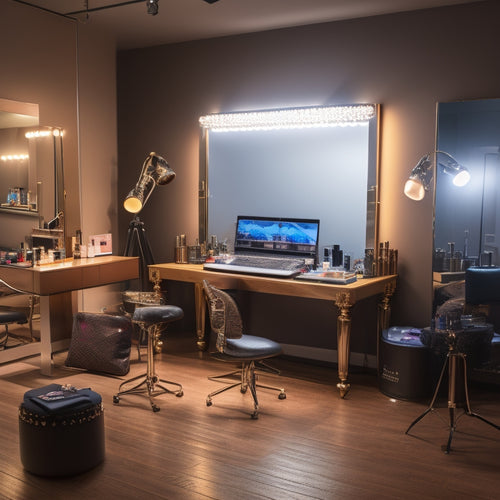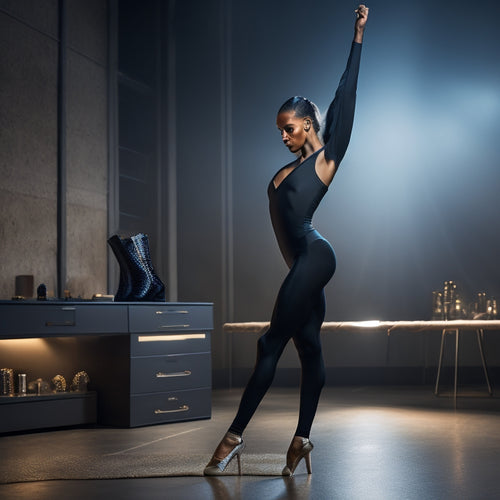
Selecting the Perfect Music for Your Dance Routine
Share
You're on a mission to craft a dance routine that leaves a lasting impression. To select the perfect music, start by understanding your unique dance style, considering tempo, beat, and emotional connection to lyrics. Guarantee cultural authenticity and explore instrumental tracks to create a sonic landscape that complements your choreography. Balance melody and rhythm, and experiment with playlists to find the ideal fit. By matching music to your mood and style, you'll elevate your performance and captivate your audience. As you refine your approach, you'll reveal the secrets to a truly unforgettable dance routine, and the perfect harmony of movement and music awaits.
Key Takeaways
• Define your dance style and identify the tempo, intensity, and emotional tone you want to convey to choose the perfect music.
• Consider the cultural authenticity of the song and ensure your interpretation pays homage to the cultural heritage of the music.
• Craft a genuine emotional connection to the lyrics to elevate your performance and convey emotional intensity through your dance.
• Experiment with different genres and create a playlist that complements your choreography and amplifies the performance impact.
• Use mood boards to visualize and organize your artistic vision, and guide your music selection to ensure alignment with your creative direction.
Understanding Your Dance Style
As you prepare to select the perfect music for your dance routine, define your dance style by identifying the specific techniques, movements, and overall aesthetic that distinguish it from others. This self-reflection is important in creating a cohesive performance that showcases your unique dance persona.
Your dance style is a reflection of your personal expression, so take the time to analyze what makes your movements distinct. Consider the dynamics, intensity, and emotional tone you aim to convey. Are you a high-energy performer or a subtle storyteller? Do you incorporate intricate footwork or dramatic arm movements?
Identifying these characteristics will help you pinpoint the music that complements your dance style. By understanding your dance persona, you'll be able to select music that amplifies your strengths and creates an engaging performance.
Music Tempo and Beat
Now that you've defined your dance style, it's time to contemplate the tempo and beat of your music, which can make or break the energy and flow of your performance. The tempo, or speed, of your music determines the pace of your movements, influencing the overall intensity and dynamism of your dance. A fast tempo can amplify your energy, while a slower tempo can create a more sensual, emotive atmosphere.
When selecting your music, consider the beat patterns that will complement your dance style. Syncopated rhythms, which emphasize off-beat accents, can add complexity and interest to your movements. Drum patterns can also play an essential role in shaping the rhythm and feel of your dance.
For example, a driving drumbeat can propel your movements forward, while a more subtle pattern can create a sense of tension and release. By carefully choosing the tempo and beat of your music, you can create a powerful, cohesive performance that showcases your unique style and artistry.
Emotional Connection to Lyrics
Crafting a genuine emotional connection to the lyrics of your dance music can elevate your performance from mere movement to a heartfelt expression of artistry. You become invested in the narrative, allowing the lyrics to guide your movements and convey a deeper meaning. This connection is essential, as it allows you to tap into the emotional resonance of the song, making your performance more genuine and engaging.
When you connect with the lyrics, you can effectively convey the emotional intensity of the song through your dance. Lyrical storytelling becomes a powerful tool, allowing you to weave a narrative that transcends mere movement. Vocal expression also plays a significant role, as the tone, pitch, and cadence of the singer's voice can influence your choreography.
Cultural Authenticity Matters
When selecting music for your dance routine, you must also consider the cultural authenticity of the song, making sure that your performance doesn't appropriate or disrespect the cultural heritage of the music's origins. This is vital in maintaining the integrity of your performance and avoiding cultural insensitivity.
You need to explore further into the song's traditional roots, understanding the cultural context in which it was created. This will help you appreciate the nuances and essence of the music, allowing you to create a more authentic and respectful performance.
Cultural sensitivity is key in this process. You must be aware of the historical and cultural significance of the music, and make sure that your interpretation doesn't dilute or distort its original meaning. By doing so, you'll be able to create a performance that not only showcases your skills but also pays homage to the cultural heritage of the music.
Choosing Instrumental Tracks
You may opt for instrumental tracks that offer a clean slate for your choreography, allowing you to focus on the rhythmic patterns and melodic structures that drive your dance movements. Without the distraction of lyrics, you can tailor the mood setting and sonic texture of your routine to perfection. Instrumental tracks provide a blank canvas, empowering you to paint a unique soundscape that complements your dance style.
| Mood Setting | Sonic Texture |
|---|---|
| Moody and introspective | Dark, pulsing synths |
| Uplifting and energetic | Bright, driving drums |
| Hypnotic and sensual | Smooth, lush pads |
When choosing instrumental tracks, consider the emotional tone you want to convey and the sonic elements that will enhance your choreography. By selecting tracks with the right mood setting and sonic texture, you'll create a cohesive and captivating dance routine that leaves a lasting impression on your audience.
Balancing Melody and Rhythm
To effectively balance melody and rhythm in your dance routine, pinpoint the instrumental tracks that strike a harmonious balance between catchy melodic hooks and infectious rhythmic patterns that drive your movements. You want to create a sonic texture that's rich and engaging, with a harmonic progression that complements your choreography.
When selecting a track, ask yourself: Does the melody evoke the emotions you want to convey, and does the rhythm energize your movements?
As you experiment with different instrumental tracks, pay attention to how the melody and rhythm interact. Do the melodic hooks complement the rhythmic patterns, or do they clash? A well-balanced track will have a clear harmonic progression that supports your dance style.
Consider the tempo, time signature, and overall energy of the track. If the melody is too dominant, it may overpower your movements. Conversely, if the rhythm is too strong, it may overshadow the melodic hooks.
Creating a Dynamic Flow
As you create a dynamic flow in your dance routine, you'll want to carefully craft moments that captivate your audience.
To do this, you'll need to build emotional peaks that resonate with your viewers, ensuring your choreography is in perfect sync with the rhythm and melody.
Building Emotional Peaks
How do you plan to weave a narrative thread throughout your dance routine, crafting a dynamic flow that ebbs and swells to mesmerize your audience? Building emotional peaks is vital to creating an unforgettable performance.
To achieve this, you'll want to craft a sonic landscape that takes your audience on a journey. Identify the crescendo moments in your music, where the energy surges and the music swells. These peaks should align with the climax of your choreography, amplifying the emotional impact on your audience.
Consider the arc of your routine, building towards these crescendo moments. As you weave your narrative thread, create contrast by juxtaposing intense sections with softer, more subtle moments. This contrast will heighten the emotional impact of your peaks, making them even more breathtaking.
Matching Rhythm and Movement
You're now tasked with synchronizing your dance movements with the rhythmic pulse of your music, making sure that every step, gesture, and pose aligns with the sonic landscape you've crafted. This harmonious marriage of movement and melody is vital in creating a dynamic flow that captivates your audience.
To achieve this, focus on the following key elements:
-
Rhythmic Expression: Allow the music's rhythmic patterns to guide your movements, using accents and syncopation to add texture and depth to your choreography.
-
Kinetic Harmony: Ensure that your movements are in harmony with the music's kinetic energy, using dynamics, phrasing, and articulation to create a sense of tension and release.
-
Phrasing and Form: Structure your choreography to mirror the music's phrasing and form, using repetition, variation, and contrast to build a cohesive narrative.
- Micro-Timing: Focus on the subtleties of timing, using micro-delays, accelerations, and decelerations to create a sense of fluidity and connection with the music.
Controlling Tempo Shifts
By expertly maneuvering tempo shifts, you can infuse dynamic energy into your dance routine, seamlessly switching between slow-burning intensity and high-octane fervor. This tempo storytelling allows you to craft a narrative that captivates your audience, drawing them into the emotional highs and lows of your performance.
To master tempo shifts, it's essential to understand shift dynamics. A gradual tempo increase can build tension, while a sudden drop can create a dramatic pause. By strategically placing tempo shifts, you can create an ebb and flow that propels your routine forward.
Consider the emotional arc of your dance: do you want to start with a slow burn, building to a frenetic climax, or burst out of the gate with high-energy choreography? By thoughtfully controlling tempo shifts, you can create a dynamic flow that leaves your audience breathless.
Matching Music to Mood
When crafting a dance routine, selecting music that resonates with your emotional tone is essential, as it amplifies the overall impact of your performance. You want to create an emotional connection with your audience, and the right music can help you achieve this. Mood swings and emotional landscapes are vital elements to take into account when choosing your music.
Here are some tips to help you match your music to your mood:
-
Identify your emotional tone:
Determine the mood you want to convey in your dance routine. Is it energetic and playful, or dark and intense? -
Choose music that complements your tone:
Select music that aligns with your emotional tone. If your tone is energetic, choose upbeat music with a fast tempo. -
Experiment with different genres:
Don't be afraid to explore different genres to find the one that best fits your mood.
-
Pay attention to lyrics:
Make sure the lyrics of your chosen song align with your emotional tone and message.
Experimenting With Playlists
As you begin experimenting with playlists, you'll want to explore different genre options to find the perfect fit for your dance routine.
Creating mood boards can also help you visualize and organize your musical choices, allowing you to curate a playlist that complements your choreography.
Exploring Genre Options
You'll find that crafting playlists with a mix of genres can help you pinpoint the perfect fit for your dance routine, and experimenting with different styles is an essential step in this process. By exploring various genres, you'll uncover unique fusion possibilities that can elevate your routine and make it stand out.
Consider the following genres to add some flair to your playlist:
-
Electronic Dance Music (EDM): Infuse your routine with high-energy beats and pulsating rhythms.
-
Retro Funk: Add a touch of nostalgia with retro influences, incorporating funky basslines and catchy hooks.
-
Hip-Hop/Rap: Incorporate powerful lyrics and strong beats to add an edgy, urban vibe to your dance.
- Indie/Alternative: Experiment with indie and alternative sounds to create a moody, atmospheric ambiance.
Creating Mood Boards
Craft your ideal dance routine soundtrack by building a playlist that resonates with your artistic vision, and start by creating a mood board that defines the tone and atmosphere you aim to convey. A mood board is a visual representation of your creative direction, helping you distill your ideas and inspirations into a cohesive vision. Gather images, colors, and textures that evoke the emotions and atmosphere you want to convey through your dance routine.
| Visual Inspiration | Color Palette | Mood |
|---|---|---|
| Dark, moody landscapes | Deep blues, purples | Ominous, intense |
| Vibrant cityscapes | Bright neons, bold primaries | Energetic, playful |
| Ethereal, dreamy skies | Soft pastels, whites | Whimsical, surreal |
| Urban, gritty textures | Dark grays, industrial tones | Edgy, rebellious |
| Nature-inspired patterns | Earthy tones, organic textures | Organic, natural |
As you curate your mood board, consider the colors, textures, and imagery that evoke the emotions and atmosphere you want to convey. This visual representation will guide your playlist creation, ensuring that your music selection aligns with your artistic vision.
Frequently Asked Questions
Can I Use a Song With Mature Themes for a Children's Dance Routine?
Like the sirens of Greek mythology, a song with mature themes may lure you in, but beware - it's important you prioritize age appropriateness and use content filtering to make sure your young dancers aren't exposed to inappropriate content.
How Do I Ensure Music Rights and Licenses for Public Performances?
When performing publicly, you'll need to navigate copyright laws to avoid legal implications; make sure you secure necessary licenses and permissions from copyright holders to avoid costly fines and lawsuits.
Can I Mix Different Genres of Music in One Dance Routine?
You can seamlessly blend genres in your dance routine by creating a cohesive narrative through musical storytelling, where contrasting styles converge to evoke a powerful emotional response, amplifying your performance's impact.
Do I Need to Consider the Audience's Musical Preferences Too?
As you step into the spotlight, you envision a sea of diverse faces, each with their own cultural significance and personal taste in music. You must consider the audience's preferences to craft a setlist that resonates with their eclectic vibes.
Can I Reuse a Song From a Previous Dance Routine or Is That Lazy?
"When reusing a song, you risk compromising your artistic integrity and originality expectation, succumbing to the choreographer's dilemma of playing it safe versus taking a creative risk, which can stifle your growth as a choreographer."
Related Posts
-

Elevate Your Dance Makeup Business Online
You're one step away from taking your dance makeup business global. A professional online presence is key, with 75% o...
-

5 Dance Performance Apparel Must-Haves for a Flawless Routine
You rely on your dancewear to deliver a flawless performance, and that's exactly what it should do. Your dance perfor...
-

Legal Battle: TikTok's Makeup Looks Ownership Uncertainty
TikTok's rise in popularity has sparked a legal battle over makeup looks ownership, leaving creators vulnerable to ex...


